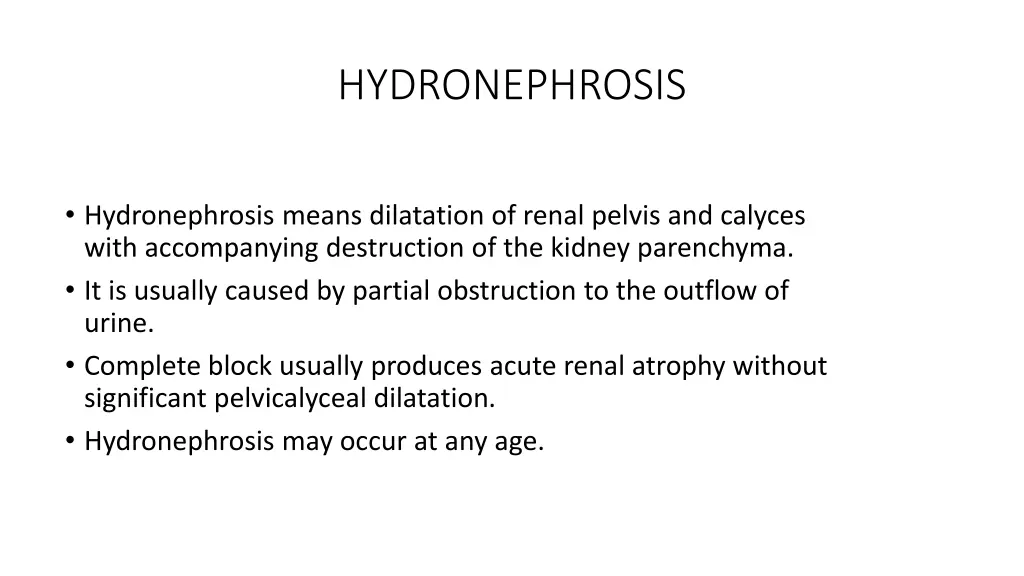
Understanding Hydronephrosis: Causes and Characteristics
Hydronephrosis is the dilation of the renal pelvis and calyces due to obstruction, leading to kidney parenchyma damage. Learn about congenital and acquired causes, unilateral vs. bilateral hydronephrosis, and the various factors contributing to this condition.
Download Presentation

Please find below an Image/Link to download the presentation.
The content on the website is provided AS IS for your information and personal use only. It may not be sold, licensed, or shared on other websites without obtaining consent from the author. If you encounter any issues during the download, it is possible that the publisher has removed the file from their server.
You are allowed to download the files provided on this website for personal or commercial use, subject to the condition that they are used lawfully. All files are the property of their respective owners.
The content on the website is provided AS IS for your information and personal use only. It may not be sold, licensed, or shared on other websites without obtaining consent from the author.
E N D
Presentation Transcript
HYDRONEPHROSIS Hydronephrosis means dilatation of renal pelvis and calyces with accompanying destruction of the kidney parenchyma. It is usually caused by partial obstruction to the outflow of urine. Complete block usually produces acute renal atrophy without significant pelvicalyceal dilatation. Hydronephrosis may occur at any age.
AETIOLOGY Hydronephrosis may be congenital or acquired. Congenital hydronephrosis means it is caused by obstruction which developed congenitally e.g. pin-hole meatus, valves and folds in the urethra. Majority of the congenital hydronephrosis are bilateral. Hydronephrosis may be unilateral or bilateral. Unilateral hydronephrosis occurs when the obstruction is somewhere in the ureter, above the level of the urinary bladder. Bilateral hydronephrosis occurs when the obstruction is below the level of the urinary bladder e.g. stricture of the urethra, benign enlargement of the prostate or neuromuscular dysfunction of the internal sphincter.
However bilateral hydronephrosis may occur due to bilateral ureteric obstruction. When there is a definite detectable cause of hydronephrosis, it is called secondary hydronephrosis. When no cause can be detected, it is called primary or idiopathic hydronephrosis
Unilateral hydronephrosis:- Obviously the cause is in the ureter and mostly it is at the pelviureteric junction. The causes can be classified into A. Extramural causes, i.e. the cause lies outside the ureter. B. Intramural causes, when the cause lies in the wall of the ureter C. Intraluminal, when the cause lies within the lumen of the ureter.
A. EXTRAMURAL CAUSES 1. Pressure on the ureter by loaded sigmoid colon, gravid uterus, uterine tumors and ovarian tumors. 2. Involvement of the ureter by malignant neoplasm outside it e.g. carcinoma of the cervix and uterus, carcinoma of the colon or caecum, carcinoma of the rectum and carcinoma of the prostate. 3. Aberrant renal vessels. These are usually seen at the junction of the pelvis and ureter. Arteries are more important in this respect. It is often a lower polar artery which supplies the inferior segment of the kidney. Such artery may not arise from the renal artery but instead from aorta, common iliac artery or spermatic or ovarian artery. Such aberrant vessel may cause hydronephrosis in children and may be considered a congenital hydronephrosis.
Intramural causes congenital stenosis Ureterocele. Neoplasm of the ureter (mostly papilloma of the ureter) is rare and may cause unilateral hydronephrosis. Intraluminal causes C. INTRALUMINAL CAUSES. 1. Calculus in the ureter is not only the most common in this group, but also the most common of unilateral hydronephrosis. This usually causes intermittent hydronephrosis (described below). 2. Congenital folds at the upper end of the ureter may cause congenital unilateral hydronephrosis. is more often seen on the right side than on the left side.
INTRALUMINAL CAUSES 1. Calculus in the ureter is not only the most common in this group, but also the most common of unilateral hydronephrosis. This usually causes intermittent hydronephrosis (described below). 2. Congenital folds at the upper end of the ureter may cause congenital unilateral hydronephrosis. is more often seen on the right side than on the left side.
Bilateral hydronephrosis. Bilateral hydronephrosis. Causes in the urethra- Pin-hole meatus is a congenital cause.Very rarely phimosis may cause congenital hydronephrosis. Benign prostatic enlargement and prostatic carcinoma are very common causes of bilateral hydronephrosis with hydroureter. Carcinoma of the cervix and uterus and carcinoma of the rectum may sometimes involve the urethra or neck of the bladder or even both ureters to cause bilateral hydronephrosis.
Causes in the bladder bladder A calculus in the urinary bladder may cause Hydronephrosis due to calculus in renal pelvis act as a ball valve to cause obstruction at the urethral meatus to cause intermittent bilateral hydronephrosis. Internal sphincter of the bladder may be unable to open due to neuromuscular dysfunction. Neoplasm of the bladder may involve both ureteric orifices to cause bilateral hydronephrosis. 4. Malignant neoplasms of adjacent organs may involve urinary bladder or both ureters to cause bilateral hydronephrosis.
PRIMARY HYDRONEPHROSIS PRIMARY HYDRONEPHROSIS There remain however a certain number of cases which have to be labelled as idiopathic' or 'primary' hydronephrosis, as no organic cause can be detected
STAGES of hydronephrosis 1. Open hydronephrosis. In this condition the hydronephrosis sac is openly communicated with the lower urinary tract, as the obstruction is incomplete. 2. Intermittent hydronephrosis Here the hydronephrotic sac intermittently communicates with the lower urinary tract, as the obstruction is complete intermittently. That means when the obstruction is complete,there is oliguria with enlargement of the hydronephrotic sac and the patient complains of pain in the loin of the same side. After sometimes the obstruction passes off. there is polyuria and diminution in the size of the sac. 3. Closed hydronephrosis. In this condition the hydronephrotic sac is completely closed from the lower urinary tract.
TYPES OF HYDRONEPHROSIS Three types are usually recognised depending on whether the kidney has an extrarenal or intrarenal or mixed type of pelvis. 1. Pelvic type. When the kidney has extrarenal (the major part of the pelvis lies outside the kidney substance) pelvis, the renal pelvis becomes grossly dilated in hydronephrosis with minimum dilatation of the calyces This type is usually seen in idiopathic form and in this type there is greatest dilatation likely to occur. Renal damage is much less as there is little distension of the calyces. It must be remembered that when hydronephrosis is due to a stone at the upper end of the ureter, accompanying inflammation causes fibrosis and thickening of the pelvis so as to unable it to dilate much.
2. Renal type. When the pelvis is intrarenal (that means the major part of the pelvis remains inside the kidney substance) there is not much dilatation of the renal pelvis but the calyces are more dilated. This causes early renal destruction owing to more dilatation of the calyces. This type is more often seen in case of calculous obstruction. 3. Pelvirenal type. This is perhaps the most common form, in which both the pelvis and the calyces are equally dilated.
CLINICAL CLINICAL FEATURES FEATURES Unilateral hydronephrosis The females are usually more often affected. Curiously enough right side is more commonly affected than the left side. Two type are usually seen : TYPE I in which the causes of hydronephrosis are the main presenting features e.g. renal colic and haematuria in calculous obstruction etc. TYPE II in which clinical features of hydronephrosis are the main presenting features. In these cases onset is insidious. There is dull ache and sense of weight on the affected side of the loin. This becomes excessive after excessive fluid intake and alcohol. On examination one can find an enlarged kidney on the affected side.
Intermittent hydronephrosis- In this type patient first complains of an acute pain which is followed by a swelling in the loin. A few hours later or even on the next day there is suddenly excess voiding of urine (polyuria), the pain is relieved and the swelling also disappears. 3 Bilateral hydronephrosis. In this condition also two types are seen. TYPE I There are symptoms of causes of hydronephrosis e.g. symptoms of benign enlargement of prostate or carcinoma of prostate or neoplasm of the bladder and there is hardly any symptom of hydronephrosis. Hydronephrosis is only revealed by special investigation.
TYPE II Bilateral renal swelling is firstly complained of but this is much rare in comparison to the unilateral hydronephrosis. Special Investigations. 1. STRAIGHT X-RA Y of the abdomen may show enlarged renal shadow and radio-opaque stones as cause of hydronephrosis. 2. EXCRETORY UROGRAPHY (I. VP.). The diagnosis is mainly confirmed by this investigation. This is only contraindicated during pregnancy. The findings in the early stages of hydronephrosis differ according to the type of hydronephrosis.
3. RETROGRADE UROGRAPHY. When excretory urography picture is inconclusive, this is a simple method which may be performed by B general surgeons. With this technique one can assess the changes of the pelvis and calyces in a better way. NEPHRECTOMY. When hydronephrosis is intrarenal, dilatation of the calyces occurs earlier at the expense of the rena parenchyma. When there is extensive damage to the renal parenchyma nephrectomy is justified provided the other kidney is functioning normal.






















